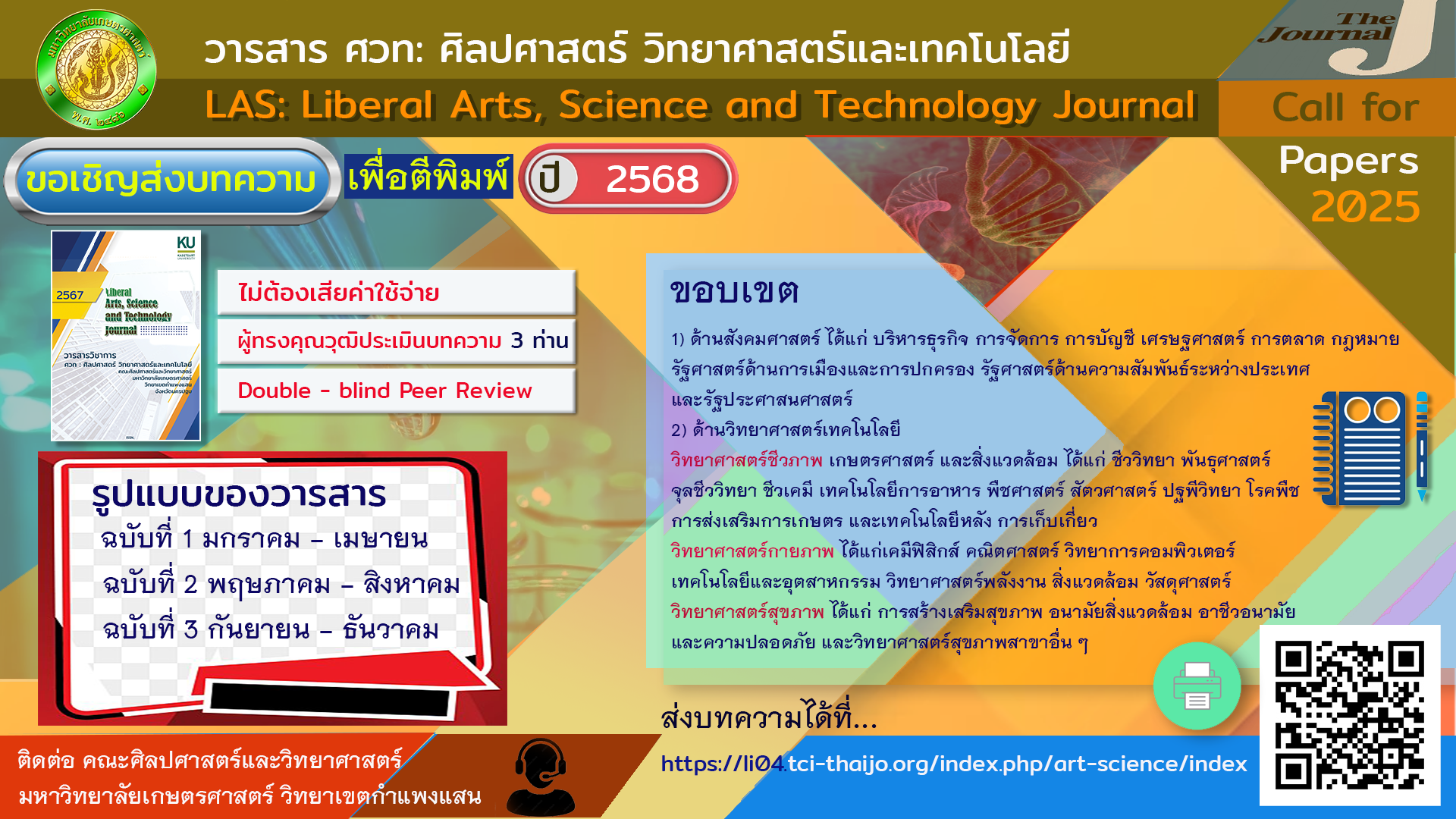การส่งบทความ
ข้อกำหนดการส่งบทความ
ในขั้นตอนการส่งบทความ ผู้แต่งต้องตรวจสอบและยืนยันว่าปฏิบัติตามข้อกำหนดการส่งบทความทุกข้อ บทความที่ไม่เป็นไปตามข้อกำหนดอาจถูกส่งคืนให้ผู้แต่งดำเนินการแก้ไข- บทความเรื่องนี้ยังไม่เคยตีพิมพ์หรืออยู่ในระหว่างการพิจารณาเพื่อตีพิมพ์ในวารสารอื่น (หากมีกรุณาอธิบายในข้อความถึงบรรณาธิการ)
-
จดหมายถึงบรรณาธิการ (จดหมายจะส่งไปยังบรรณาธิการเท่านั้น ไม่ส่งไปยัง reviewer)
- บทความเตรียมในรูปแบบของไฟล์ Microsoft Word
-
Manuscript File มี 2 ไฟล์ (1) ไฟล์ที่ไม่มีชื่อและที่อยู่ผู้แต่ง (2) ไฟล์ที่มีชื่อและที่อยู่ผู้แต่ง
Separated Manuscript File with author (s) name, affiliations and Manuscript File without author (s) name and affiliations - บทความเตรียมตามข้อกำหนด ทั้งในด้านของรูปแบบและการเขียนเอกสารอ้างอิง ตามคำแนะนำสำหรับผู้แต่ง (Author Guidelines)
- บทความพิมพ์แบบใช้ระยะห่างบรรทัดปกติ (single-spaced) และ ระบุข้อมูล รูปวาด รูปภาพ และตาราง ในตำแหน่งที่เหมาะสม เป็นตามข้อกำหนดของวารสาร ใน Template
- มีการให้ URLs ที่เข้าถึงได้ สำหรับเอกสารที่อ้างอิงจากอินเทอร์เน็ต
- กรุณาเพิ่มรายชื่อผู้แต่งในระบบตามลำดับให้ครบถ้วนเหมือนกับใน manuscript
Research Article
-บทความวิจัย (Research Article) เป็นบทความที่มีการดำเนินการทดลอง มีผลการทดลองที่แน่ชัด ถูกต้องตามหลักวิทยาศาสตร์ สามารถทำซ้ำได้ เนื้อหาบทความประกอบด้วย บทคัดย่อ บทนำ ระเบียบวิธีวิจัย/วิธีการทดลอง ผลการวิจัย วิจารณ์และข้อเสนอแนะ และบทสรุป โดยจำกัด บทคัดย่อทั้งภาษาไทยและภาษาอังกฤษไม่เกิดอย่างละ 300 คำ
Review Article
-บทความปริทัศน์ (Review Article) เป็นบทความบรรยายองค์ความรู้ในศาสตร์เฉพาะทางนั้น ๆ ที่เกี่ยวข้องกับเป้าหมายและขอบเขตการรับตีพิมพ์ของวารสาร โดยผู้เขียนต้องติดต่อบรรณาธิการเพื่อนำเสนอรายละเอียดเบื้องต้นก่อนการส่งตีพิมพ์ในระบบ
Short communication
-รายงานฉบับย่อ (Short communication) เป็นบทความที่นำเสนอสิ่งใหม่ และต้องการสื่อสารทางวิทยาศาสตร์ให้ชุมชนวิทยาศาสตร์ทราบอย่างรวดเร็ว มีความสั้น กระชับและมีหลักฐานปรากฏชัดเจนในการค้นพบ เนื้อหาบทความประกอบด้วย บทคัดย่อ บทนำ ระเบียบวิธีวิจัย/วิธีการทดลอง ผลการวิจัย วิจารณ์และข้อเสนอแนะ และบทสรุป โดยจำกัด บทคัดย่อทั้งภาษาไทยและภาษาอังกฤษไม่เกิดอย่างละ 200 คำ และเอกสารอ้างอิงไม่เกิน 25 เอกสาร
ประกาศลิขสิทธิ์
ข้อถือสิทธิ์
-บทความที่ได้รับการตีพิมพ์ ถือเป็นกรรมสิทธิ์ของคณะศิลปศาสตร์และวิทยาศาสตร์ เนื้อหาบทความที่ปรากฏในวารสารเป็นความรับผิดชอบของผู้เขียน ทั้งนี้ไม่รวมความผิดพลาด อันเกิดจากเทคนิคการพิมพ์
-การส่งบทความตีพิมพ์และกระบวนการพิจารณาบทความไม่มีค่าใช้จ่าย
ประกาศเกี่ยวกับลิขสิทธิ์
-บทความ ข้อมูล เนื้อหา ที่ได้รับการตีพิมพ์ในวารสาร ถือเป็นลิขสิทธิ์ของวารสาร หากบุคคลหรือหน่วยงานใดต้องการนำทั้งหมดหรือส่วนหนึ่งส่วนใดไปเผยแพร่ต่อหรือกระทำการใด ๆ จะต้องได้รับอนุญาตจากวารสาร
-วาสารมีความเป็นกลางในด้านรูปภาพโดยเป็นนความรับผิดชอบของผู้เขียนบทความโดยตรง รวมทั้งเนื้อหาบทความที่ปรากฏในบทความเป็นความรับผิดชอบของผู้เขียนบทความโดยตรงเช่นกัน ซึ่งกองบรรณาธิการวารสารไม่จำเป็นต้องเห็นด้วยหรือมีส่วนร่วมรับผิดชอบใด ๆ
-หากตรวจพบการคัดลอกบทความวิจัย (plagiarism) จะถือเป็นความรับผิดชอบของผู้ส่งผลงานตีพิมพ์แต่เพียงผู้เดียว
นโยบายส่วนบุคคล
ชื่อ ที่อยู่ และข้อมูลทางสารสนเทศ หรือข้อมูลส่วนบุคคล ที่ในเว็บไซต์วารสารนี้ใช้สำหรับวัตถุประสงค์ที่ระบุไว้ในงานวารสารเท่านั้นและจะไม่เปิดเผยเพื่อวัตถุประสงค์ในกิจกรรมอื่น ๆ หรือให้กับบุคคลหรือหน่วยงานอื่นใดทราบ
นโยบายความเป็นส่วนตัว
ข้อถือสิทธิ์
-บทความที่ได้รับการตีพิมพ์ ถือเป็นกรรมสิทธิ์ของคณะศิลปะศาสตร์และวิทยาศาสตร์ เนื้อหาบทความที่ปรากฏในวารสารเป็นความรับผิดชอบของผู้เขียน ทั้งนี้ไม่รวมความผิดพลาด อันเกิดจากเทคนิคการพิมพ์
-การส่งบทความตีพิมพ์และกระบวนการพิจารณาบทความไม่มีค่าใช้จ่าย
ประกาศเกี่ยวกับลิขสิทธิ์
-บทความ ข้อมูล เนื้อหา ที่ได้รับการตีพิมพ์ในวารสาร ถือเป็นลิขสิทธิ์ของวารสาร หากบุคคลหรือหน่วยงานใดต้องการนำทั้งหมดหรือส่วนหนึ่งส่วนใดไปเผยแพร่ต่อหรือกระทำการใด ๆ จะต้องได้รับอนุญาตจากวารสาร
-วาสารมีความเป็นกลางในด้านรูปภาพโดยเป็นนความรับผิดชอบของผู้เขียนบทความโดยตรง รวมทั้งเนื้อหาบทความที่ปรากฏในบทความเป็นความรับผิดชอบของผู้เขียนบทความโดยตรงเช่นกัน ซึ่งกองบรรณาธิการวารสารไม่จำเป็นต้องเห็นด้วยหรือมีส่วนร่วมรับผิดชอบใด ๆ
-หากตรวจพบการคัดลอกบทความวิจัย (plagiarism) จะถือเป็นความรับผิดชอบของผู้ส่งผลงานตีพิมพ์แต่เพียงผู้เดียว
นโยบายส่วนบุคคล
ชื่อ ที่อยู่ และข้อมูลทางสารสนเทศ หรือข้อมูลส่วนบุคคล ที่ในเว็บไซต์วารสารนี้ใช้สำหรับวัตถุประสงค์ที่ระบุไว้ในงานวารสารเท่านั้นและจะไม่เปิดเผยเพื่อวัตถุประสงค์ในกิจกรรมอื่น ๆ หรือให้กับบุคคลหรือหน่วยงานอื่นใดทราบ






